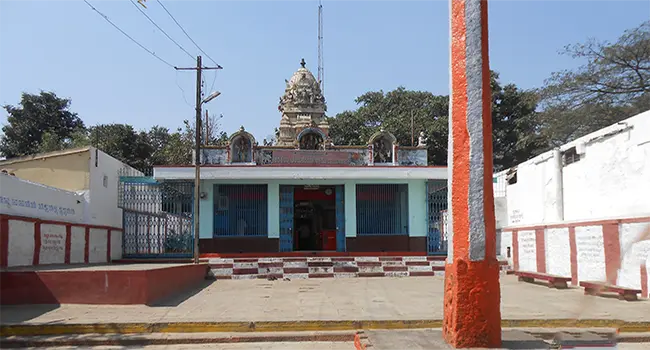
The Fort of Bangalore
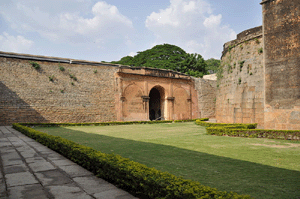 Pic. Courtesy :wikipedia.org
Pic. Courtesy :wikipedia.org
Kempe Gowda, a feudatory of the Vijayanagar Empire had constructed a mud fort in Bangalore and made it his seat of rule. Around the fort, he had developed ‘petas’ for many artisans and trades. Thus the town grew in size and style. As a devoted Hindu, he had always encouraged the construction of temples and agraharams around the temples. He thus made Bangalore a business hub as well as a cultural center. This dynasty developed Bangalore further to the envy of others. Although it was not strategically an important place for commerce the development done by the Gowdas had invited envy and soon Bangalore fell into the hands of Bijapur Sultans. The Mughals in turn gave it to Wodeyars for consideration.
A new oval-shaped fort was built south of the old mud fort. Again the reign changed to Hyder Ali and then to the British. Hyder Ali rebuilt the oval fort in stone as part of his defense strategy. Ever since Bangalore developed into a commercial and military center of strategic importance. The work started by Hyder Ali to build this fort was completed by Tipu Sultan. After Bangalore came under the control of the British, they neglected the maintenance of the fort because it was in the midst of a cluster of commercial “petas”, denying the exclusivity they needed.
Armory within the Fort
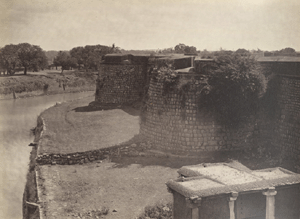 Pic. Courtesy :wikipedia.org
Pic. Courtesy :wikipedia.org
It is important to note that the fort housed the entire armory of the earlier rulers. All governmental works were executed from the fort, and most of the important officials lived and operated there until the reign of Tipu Sultan.
With the influence of the Dutch, French, and English people, new methods of warfare had come into operation. The local rulers also adopted the same and accordingly, the arsenals for the war had to be changed. Therefore Hyder Ali introduced new weapons along with the traditional ones. The inventory of the armory grew with more enemies around. The safe storing of large quantities of armory became important. To make way for this within the fort, the officials who were then residing within the fort had to be moved out.
Kare Kallu Sri Anjaneya was inside the fort, there was a tradition of placing all the weapons before the deity only then were the weapons used in the war field. This tradition was continued even after the temple was shifted to a new location outside the Fort.
Sri Anjaneya worshipers
Even from the days of Kempe Gowda, the Vijaynagar tradition of worshiping Sri Hanuman as the deity for bestowing braveness and success was in vogue. Although the reigns had changed people who lived within the fort continued the worship of Lord Hanuman. There were many Sri Anjaneya worshippers inside the fort. When they were to move out, they took along with them the idol of Sri Anjaneya. The administrators of the fort provided the devotees with adequate space to build a temple for Hanumanji at a short distance from the Fort.
Kare Kallu Sri Anjaneya
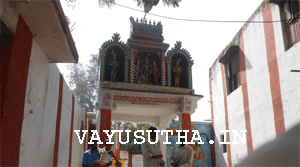 The deity was known popularly as “Kare Kallu Sri Anjaneya”. In Kannada “kare” means black and “Kallu” means stone. The idol of Sri Anjaneya Swamy was made out of dark black granite stone hence this name. When Kare Kallu Sri Anjaneya was inside the fort there was a tradition of placing all the weapons before the deity and only then were the weapons used in the war field. This tradition was continued even after the temple was shifted to a new location outside the Fort. It was strongly believed that with the blessing of Sri Kare Kallu Anjaneya, the enemy would be destroyed and victory would be assured.
The deity was known popularly as “Kare Kallu Sri Anjaneya”. In Kannada “kare” means black and “Kallu” means stone. The idol of Sri Anjaneya Swamy was made out of dark black granite stone hence this name. When Kare Kallu Sri Anjaneya was inside the fort there was a tradition of placing all the weapons before the deity and only then were the weapons used in the war field. This tradition was continued even after the temple was shifted to a new location outside the Fort. It was strongly believed that with the blessing of Sri Kare Kallu Anjaneya, the enemy would be destroyed and victory would be assured.
Kare Kallu Sri Anjaneya Swamy Temple
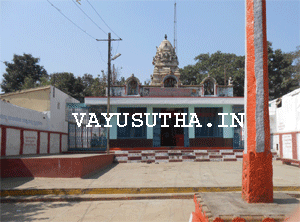 Today this big temple for Sri Anjaneya Swamy is located just opposite the Police Quarters on the main Mysore Road. It is within a very short distance from the Bangalore fort. The Mysore Road is laid east to west at this point and this temple is on the left wing of the road as one moves from the Fort. The temple, though on the main road, is tucked inside and one can see the arch that leads to the temple. The temple has a three-tiered “Vimanam”.
Today this big temple for Sri Anjaneya Swamy is located just opposite the Police Quarters on the main Mysore Road. It is within a very short distance from the Bangalore fort. The Mysore Road is laid east to west at this point and this temple is on the left wing of the road as one moves from the Fort. The temple, though on the main road, is tucked inside and one can see the arch that leads to the temple. The temple has a three-tiered “Vimanam”.
Entrance to the temple is through this arch which is north-facing. It is on an elevated plain and one has to climb a few steps, to reach the entrance. The tall and beautifully designed porch holds the arch, crowned by Sri Rama Parivara in the center, flanked by Sri Anjaneya and Sri Garuda. One will step into an open space through this arch. In the center of the open space is the ‘dwaja stambam’. Three small arches can be seen on the terrace of the temple. At the center is Sri Rama Parivara, on the right side is the idol of Sri Gopalakrishna, and on the left is Sri Mahavishnu.
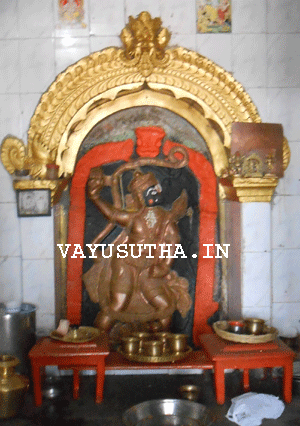 One can have a clear darshan of Lord Anjaneya from near the dwaja stamba itself.
One can have a clear darshan of Lord Anjaneya from near the dwaja stamba itself.
The Deity Sri Kare Kallu Anjaneya Swamy
The idol of Sri Anjaneya Swamy is about six feet tall. The idol shows the deity in walking posture and it is of ‘ardha shila’ type. East east-facing Lord is seen as if walking Northward with His left lotus foot in the front. His right lotus foot is slightly raised and only His toe is touching the ground. Both His feet are adorned with the ornament “thandai”. His dothi- in a tight kacham – clings tightly to his thighs. His waist is adorned with decorative belt-like ornament and also houses a small knife. His Left hand is holding the stem of the sowgandika flower with its leaves. The flower is in a ‘yet to blossom’ state and is seen above His left shoulder. His raised right-hand shows the ‘abaya mudra’ - showering blessings on His devotees. His two hands are adorned with bracelets on the wrists and keyur in the arms. He is wearing two garlands, one garland has a pendant attached to it. The sacred thread- ‘yagnyopavidham’- adores His chest. On His shoulders rests the ‘uttariyam’ – the upper garment. The raised tail of the Lord is seen as if in “Ohm” form. The curved end of the tail rises above His head and is adorned with a small beautiful bell. The Lord is wearing earrings. His “kesam” is neatly tied. He is wearing a crown. His face is calm and quiet and at the same time, it shows strong braveness. His protruding teeth are in confirmation of this strength. His bright, brilliant, and fearless eyes only add to the even otherwise grand appearance of the Lord.
Location of the temple: "KareKallu Sri Anjaneya Swamy Temple, Bengaluru"
Experience
Come to this kshetra and pray to Kare Kallu Lord Anjaneya to regain all lost courage and face the challenges bravely.
SRI HANUMAN THINKS DIFFERENTLY, THINKS FAST
THINKS AHEAD AND ACTS FOR SURE
Ed [April 2014]
Updates: [Jan 2025]
